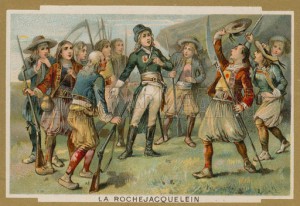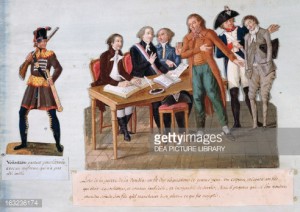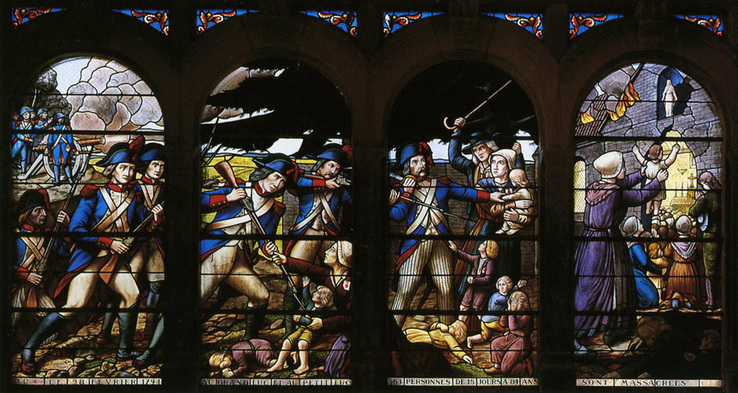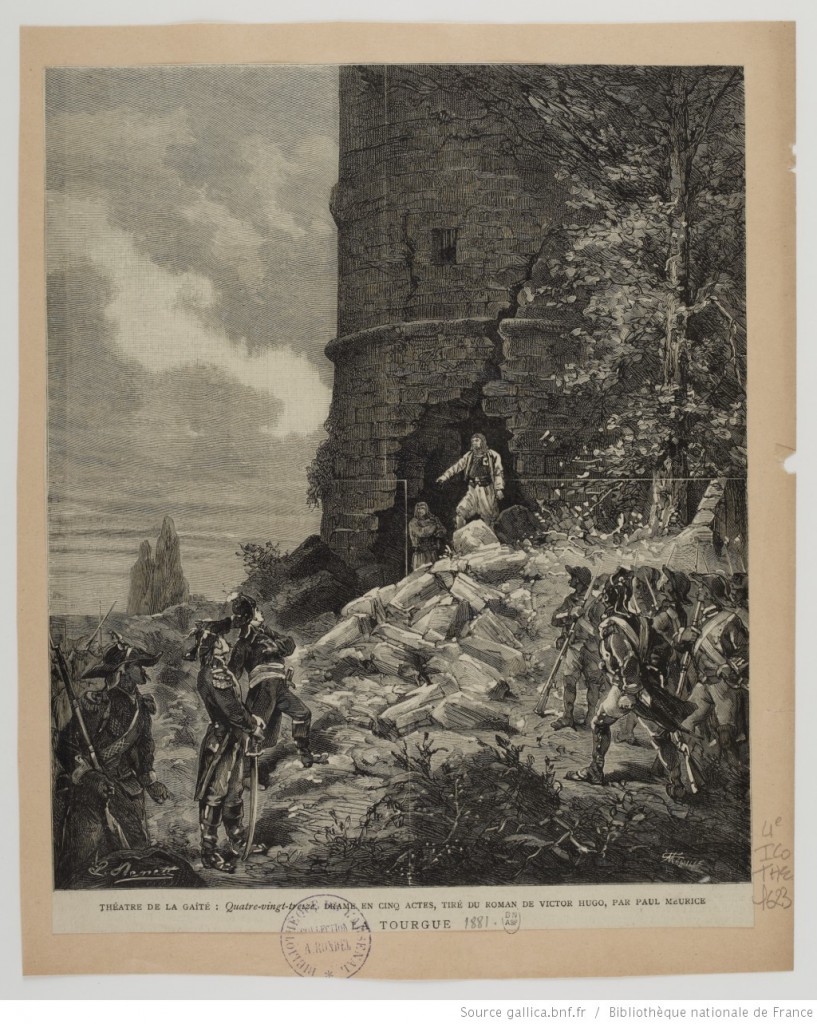Marisa Linton
Kingston University
Quatrevingt-treize (Ninety-Three in its English translation) was Victor Hugo’s last novel, published in 1874, twelve years after Les Misérables.[1] Though he had originally conceived the idea for the novel several years before the Paris Commune of 1871, he undoubtedly had the Commune in mind as he wrote it, above all that terrible week in May 1871 when many thousands of insurgents were killed on the streets of Paris. Yet Hugo’s subject was not the present but the past: the greatest –and most terrible– period of the French Revolution –the year 1793. Hugo had seen the Revolutions of 1830 and 1848 at first hand; he believed passionately that the revolutionary cause was a just one, and that ultimately it would triumph. He had shown that commitment in his account of the life-and-death struggle on the barricade that forms the climax to Les Misérables (though people whose knowledge of Hugo’s politics begins and ends with the musical version of “Les Mis” may not be aware that he saw the slaughter on the barricade as anything other than a pointless loss of life).[2] In Quatrevingt-treize he returned to confront this theme and to tackle the first French Revolution. His task might have been pleasanter had he set his novel in 1789, the time of heady optimism when, to invoke the phrase so often used since, France gave the world “liberty, equality, fraternity – and the rights of man.” But that was not Victor Hugo’s way. He did not shy away from the time four years later when political violence, betrayal and terror overtook the early idealism. He took as his subject one of the darkest moments of the Revolution, the revolutionary wars in the department of the Vendée and neighbouring Brittany.
It often comes as a surprise to students that by far the greatest loss of life in the French Revolution took place not in Paris where, except for the fraught weeks in June and July 1794, relatively few ‘counterrevolutionaries’ were sent to the guillotine, but in the civil war in the Vendée that began in March 1793 as a peasant uprising. The local population refused the Revolution’s demands, in a furious and spontaneous reaction to the decreed levy of 300,000 men to fight against the foreign armies that had crossed France’s borders. Peasants, both in the Vendée and the Chouans in Brittany engaged in guerrilla-style warfare against the Revolution’s soldiers, using whatever weapons came to hand.
The conflict escalated: noble émigrés and priests opposed to the new Constitution joined forces to support and lead the conflict.The Breton coast became the site of a hoped-for English landing.The roots of the conflict lay in a rejection of the Revolution’s religious policies, the reaction to conscription, and local tensions between the towns (largely in favour of the Revolution) and the countryside (largely against).[3] The local landscape known as bocage, characterised by small fields bounded by high hedges, sunken lanes, and dense forests into which armed rebels could disappear, described in atmospheric detail by Hugo, lent itself to guerrilla fighting. Both rebels, “the Whites,” and republican soldiers, “the Blues,” died in their tens of thousands. Both sides resorted to atrocities, massacres. and pitiless killing of the vanquished. The legacy of the Vendée has provoked bitter controversy. Reynald Secher contended that the conflict in the Vendée constituted a “French genocide,” but the consensus of almost every reputable historian is that what happened was not a genocide but a civil war.[4]
Hugo’s personal history was bound up with the traumatic history of the Vendée, for both his parents were involved in the conflict, though on opposing sides. His mother was from a Breton bourgeois family, originally from Nantes, a fervent royalist and devout Catholic. His father was a career soldier from a military family; in 1793, at the age of twenty, he led a battalion against insurgents in the Vendée. Despite being in different camps, Victor Hugo’s parents met in 1796 at Châteaubriant and married the following year. This Romeo and Juliet of the Revolution continued to differ about politics, a situation which must have been uncomfortable for the young Victor and his brothers. The father went on to become a general under Napoleon, whilst the mother was party to a conspiracy against the emperor. Victor Hugo must have heard very different accounts of the war from his parents. Under his mother’s influence he started out a royalist, only later becoming a republican. Those clashing perspectives continued to resonate inside him. It is this internal conflict that gives Quatrevingt-treize its great power: Hugo’s insight into the motives of the protagonists and his capacity to sympathise with both sides of the political divide, the old world and the new.
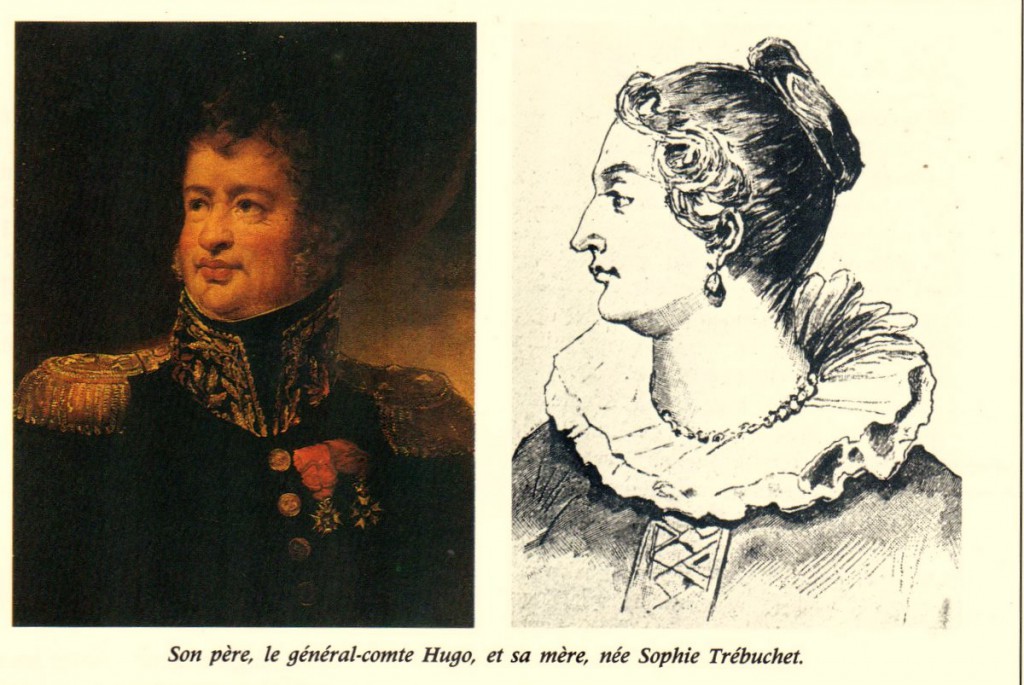 Three principal protagonists epitomise different attitudes towards the ethics of the conflict. We meet the first at the book’s opening, on board ship. He is the marquis de Lantenac, a Breton noble, who disguises himself as a peasant after landing on the western coast. His mission, which he pursues with ruthless single-mindedness, is to act as a leader to the rebels, harness them to the royalist cause and contrive an opportunity for an English military invasion. Lantenac has “always lived at Versailles” (p. 251). We are told he knows nothing of the people of Brittany and cares nothing for them; all he wants is to restore the Old Regime, its monarchy, its clergy (though he himself is a religious sceptic) and its nobility, and to smash the revolutionaries whom he dismisses with contempt as fools and villains. Against Lantenac is pitted his great-nephew, Gauvain, formerly the vicomte de Gauvain, who has renounced his noble heritage and embraced the republican cause. Gauvain commands the republican troops tasked with hunting down and killing Lantenac. The third protagonist is Cimourdain, once a priest and Gauvain’s tutor, now a fervent revolutionary. It was from Cimourdain that Gauvain first learned the political ideals he has adopted. Cimourdain has a secret, the one weak spot in his ideological armour, for he loves Gauvain, has loved him since childhood, like the son he himself never had. Cimourdain is sent by the revolutionary leader, Marat, as a special agent to the Vendée to ensure that Gauvain does not waver in his loyalty, for Marat has heard disturbing rumours that Gauvain may be capable of mercy, and revolutionary leaders view this as a cardinal sin. The scene is then set for a conflict played out both in the Breton landscape and in the minds and hearts of these three protagonists.
Three principal protagonists epitomise different attitudes towards the ethics of the conflict. We meet the first at the book’s opening, on board ship. He is the marquis de Lantenac, a Breton noble, who disguises himself as a peasant after landing on the western coast. His mission, which he pursues with ruthless single-mindedness, is to act as a leader to the rebels, harness them to the royalist cause and contrive an opportunity for an English military invasion. Lantenac has “always lived at Versailles” (p. 251). We are told he knows nothing of the people of Brittany and cares nothing for them; all he wants is to restore the Old Regime, its monarchy, its clergy (though he himself is a religious sceptic) and its nobility, and to smash the revolutionaries whom he dismisses with contempt as fools and villains. Against Lantenac is pitted his great-nephew, Gauvain, formerly the vicomte de Gauvain, who has renounced his noble heritage and embraced the republican cause. Gauvain commands the republican troops tasked with hunting down and killing Lantenac. The third protagonist is Cimourdain, once a priest and Gauvain’s tutor, now a fervent revolutionary. It was from Cimourdain that Gauvain first learned the political ideals he has adopted. Cimourdain has a secret, the one weak spot in his ideological armour, for he loves Gauvain, has loved him since childhood, like the son he himself never had. Cimourdain is sent by the revolutionary leader, Marat, as a special agent to the Vendée to ensure that Gauvain does not waver in his loyalty, for Marat has heard disturbing rumours that Gauvain may be capable of mercy, and revolutionary leaders view this as a cardinal sin. The scene is then set for a conflict played out both in the Breton landscape and in the minds and hearts of these three protagonists.
Whilst Hugo makes it clear that he believes the revolutionaries’ cause was the right one and that the Revolution would ultimately benefit humanity, there are no straightforward heroes in this novel; almost everyone is shown capable of killing for their cause. The only exceptions are the humblest citizens: a beggar who saves the marquis de Lantenac’s life on the understanding that his mission in Brittany is to stop the carnage (only for Lantenac to promptly betray that naïve trust), and a peasant woman, Michelle Fléchard, and her three small children, who are fleeing the conflict, after the republicans killed her husband. Desolate and lost, Michelle and her small family are adopted by a troop of Blues, but when the troop are killed by royalist rebels, Lantenac orders the shooting of Michelle Fléchard and takes her children as hostages. She is found, wounded but still alive, by the beggar who had saved Lantenac. He tends her wounds, but as soon as she is able she sets off across the war-torn landscape, desperate to find her children. Hugo describes the woman’s plight in chilling terms, noting “civil wars leave many such,” and he notes “the bargains proposed and submitted to” in exchange for bread, or sometimes simply “to obtain information” on her children’s whereabouts: “A wretched woman is more unfortunate than a wretched man, for she may be a prey to lust.” (pp. 276-7). It is a long time since I first read this book, and in reading it again for this review I was struck by the contemporary resonances of a civil war in which the chief sufferers are civilians, especially women and children.
It is not always an easy task to persuade students to read nineteenth-century novels, but this book will repay their efforts. I would recommend two sections in particular. The first is the account in Book III of a meeting of the Convention, brought to life in scenes that are both vivid and carry a ring of authenticity. Hugo evokes deputy after deputy, acknowledging their human failings, their quarrels, rivalries, weaknesses, ambitions; yet at the same time he conveys how collectively, in those extreme times, they acquired an almost mythological status, “always when the Convention presents itself before the reflection of any man, whosoever he may be, historian or philosopher, –that man pauses and meditates. It would be impossible not to remain thoughtfully attentive before this grand procession of shadows” (p. 169). Then comes a (fictional) account of a meeting between Danton, Robespierre, and Marat, where they express different attitudes towards what constitutes a necessary intervention, with Marat naturally at the most extreme, and where Hugo emphasises their mutual dislike and distrust. It is then they decide that Cimourdain must be sent to the Vendée.
Cimourdain and Gauvain source: Gallica
But the most important section of the novel comes in the concluding part, Book VII. Here the tensions between Lantenac, Cimourdain, and Gauvain flare into dramatic life and come to their inexorable conclusion. Gauvain’s forces have trapped Lantenac and his men at the old Gauvain family fortress of La Tourgue. Lantenac has ordered the three peasant children to be locked in a room which will be set on fire should the republicans attack. A desperate fight ensues, from which miraculously Lantenac escapes, only to return voluntarily to rescue the children from being burned alive, when he realises that he alone has the key to the door behind which they are locked. He accepts that the reward for his good action is to be put to death as a counterrevolutionary: that certainly is Cimourdain’s intention. But in Book VI Gauvain struggles between his revolutionary convictions and his revulsion at having Lantenac die for his selfless act. Gauvain is torn between the incompatible worldviews of his two mentors. It raises a terrible conflict: must Lantenac die so that the Revolution can survive? If he frees Lantenac, the nobleman will resume his war against the Revolution and many more people will die. Gauvain’s personal dilemma recalls the debates over the trial of Louis XVI (always a good subject for student discussion) and Saint-Just’s statement: “For myself I see no middle way: this man must reign or die.”[5] Gauvain cannot be so cold-bloodedly detached. Depending on one’s point of view – and students can debate this – he shows himself either weak or more humane. He contrives Lantenac’s escape, ready to face the consequences. The devastated Cimourdain casts the decisive vote at the military tribunal that condemns Gauvain to death. Gauvain expresses himself as content with the verdict – the only possible outcome for his betrayal of his duty. His mind is already elsewhere, as he confides to Cimourdain, he is thinking “of the future” (p. 388). As Gauvain’s head falls beneath the guillotine, Cimourdain, who has presided over the execution, shoots himself.
 The extraordinary power of Hugo’s book comes from his insights into the complex motivations that drive his characters. Even the worst perpetrator, Lantenac’s henchman, Imanus, whose last action, though mortally wounded, is to light the fuse which leads to the room where the children are imprisoned, has his reasons. We are told that Imanus’s own family died under the guillotine, and with his dying breath he says: “I take vengeance on their little ones for the fate of our little one, –the king shut up in the Temple!” (p. 320). He is moved by retribution, hatred and for him understandable –but ultimately self-destructive– desire for revenge. Civil war is all about that. It brought to my mind a passage in Camille Desmoulins’ Le Vieux Cordelier in which he spoke of the futility of using terror to kill counterrevolutionaries: “You want to exterminate all your enemies by means of the guillotine! Yet has there ever been a greater madness? Can you contrive to let one person perish on the scaffold without creating ten more enemies for you from his family or friends?”[6] If students can get through the nineteenth-century language, they will find much in Victor Hugo’s book to debate and ponder over, and moral and political problems as pertinent and difficult now as they were in 1793.
The extraordinary power of Hugo’s book comes from his insights into the complex motivations that drive his characters. Even the worst perpetrator, Lantenac’s henchman, Imanus, whose last action, though mortally wounded, is to light the fuse which leads to the room where the children are imprisoned, has his reasons. We are told that Imanus’s own family died under the guillotine, and with his dying breath he says: “I take vengeance on their little ones for the fate of our little one, –the king shut up in the Temple!” (p. 320). He is moved by retribution, hatred and for him understandable –but ultimately self-destructive– desire for revenge. Civil war is all about that. It brought to my mind a passage in Camille Desmoulins’ Le Vieux Cordelier in which he spoke of the futility of using terror to kill counterrevolutionaries: “You want to exterminate all your enemies by means of the guillotine! Yet has there ever been a greater madness? Can you contrive to let one person perish on the scaffold without creating ten more enemies for you from his family or friends?”[6] If students can get through the nineteenth-century language, they will find much in Victor Hugo’s book to debate and ponder over, and moral and political problems as pertinent and difficult now as they were in 1793.
Victor Hugo, Ninety-Three (New York: Carroll and Graf, 1988).
NOTES
- There are few English translations of Ninety-Three and none of recent date. I read the book in the following edition, in a translation made just months after the book was first published: Victor Hugo, Ninety-Three, translated by Frank Lee Benedict, and reprinted with an Introduction by Graham Robb (New York: Carroll and Graf, 1988). The page references are to this edition.
- See Charles Walton’s deft comparison between the tuneful but apolitical musical directed by Tom Hooper and the political perspective of the novel, “The Missing Half of Les Mis: the Film’s Pessimistic View of Revolution – and Ours,” Foreign Affairs, (2 January 2013) at: https://www.foreignaffairs.com/articles/france/2013-01-02/missing-half-les-mis.
- Amongst the many works on the Vendée one of the most illuminating is Jean-Clément Martin, La Vendée et la France (Paris: Le Seuil, 1986). On the religious context of this region, see Timothy Tackett, “The West in France: the Religious Factor in the Origins of the Counterrevolution,” Journal of Modern History, 54 (1982): 715-745.
- Reynald Secher, A French Genocide: the Vendée, translated by George Holoch (Notre Dame, Ind., University of Notre Dame Press, 2003). See Peter McPhee’s comprehensive demolition of Secher’s claim that the Vendée was a genocide, in his review of the English translation of Secher’s book, for H-France, vol. 4, No. 26 (2004) at: http://www.h-france.net/vol4reviews/vol4no26McPhee.pdf.
- “Discours sur le jugement de Louis XVI, prononcé à la Convention nationale, dans la séance du 13 novembre 1792,” in Louis-Antoine Saint-Just, Oeuvres complètes, ed. Michèle Duval (Paris: Éditions Ivrea, 1989), 378.
- Camille Desmoulins, Le Vieux Cordelier, ed. Pierre Pachet (Alençon: Belin, 1987), Issue 4: 62.


